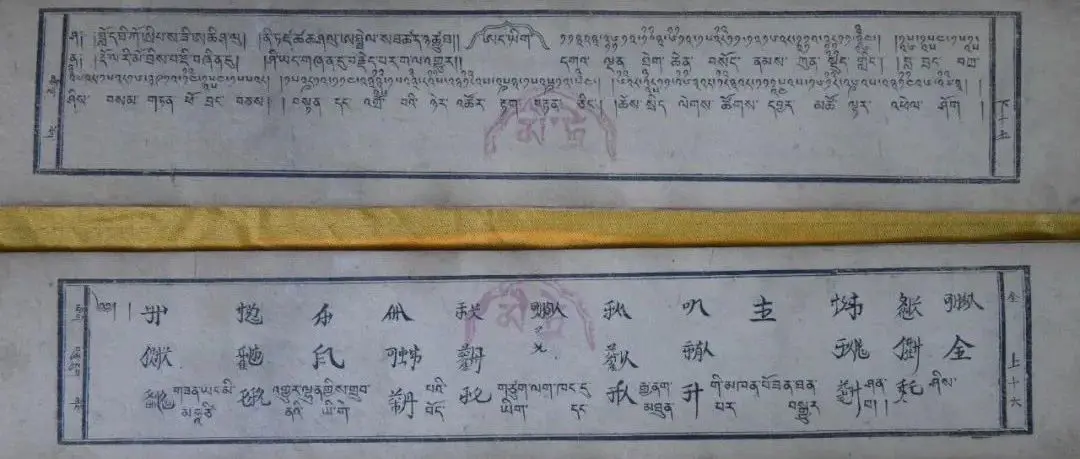How to excavate and utilize the resources of ethnic ancient documents effectively?

Chinese culture is the culmination of the cultures of all ethnic groups. The ancient documents and literature of the ethnic groups are the crystallization of the cultural wisdom of the various ethnicities of China. For the Chinese nation and Chinese civilization, they contain profound cultural genes and are an integral part of Chinese culture. Author: Meng Lingzhuo

China is a unified multi-ethnic country. Over thousands of years, various ethnic groups have left behind rich and valuable cultural resources through their integration and development. Ethnic ancient documents and literature are the witnesses and records of the excellent traditional Chinese culture and its long history. They are the cultural nutrients for the unity and progress of the Chinese nation, and also the cultural treasures that strengthen the sense of community for the Chinese nation.
As an important part of Chinese culture, what values do the ancient documents of ethnic groups carry? What kind of colorful ethnic cultures do they contain? How can we interpret the multicultural pattern of the Chinese nation from these ancient documents? What is the connection between them and the consciousness of the Chinese national community? Recently, Hai Chunsheng, a national expert in the national minority ancient documents expert database and the curator of the Fuxin Municipal Committee of the Chinese People's Political Consultative Conference's Cultural History Museum, accepted an exclusive interview with China News Service's "East and West" column.
The following is a summary of the interview transcript:
Reporter from China News Service: Why is it said that the ancient documents of ethnic groups are the cultural treasures that strengthen the consciousness of the Chinese national community?
**
**
Hai Chunsheng: Ancient texts and documents, as important carriers of China's excellent traditional culture, are irreplaceable and significant cultural resources, playing a crucial role in the inheritance and development of the Chinese cultural heritage. Chinese culture is a culmination of the cultures of various ethnic groups, and the ancient documents of these ethnic groups are crystallizations of the cultural wisdom of the Chinese people. They contain profound cultural genes and are an integral part of Chinese culture. For instance, the awe-inspiring epic works such as "The King Gesar," "Manas," and "Jangar" are collectively created by various ethnic groups. The ancient documents of ethnic minorities are rich and profound, and they complement and integrate with ancient Chinese texts, contributing to the enduring vitality of Chinese culture and the foundation of cultural confidence.
The ancient records of the ethnic groups contain the magnificent history of the formation and development of the Chinese nation, as well as the profound traditional Chinese culture. On one hand, these records document the history of various ethnic groups consolidating the frontier, defending the integrity of national territory, maintaining national unity and ethnic solidarity, and the interaction and integration among different ethnic groups. They also chronicle the history of ethnic groups supporting the governance and interaction of successive central governments in the border regions, and bear witness to the formation and development of the multi-ethnic unity pattern of the Chinese nation. On the other hand, these ancient texts carry the essence of Chinese civilization, embodying the core concepts, traditional virtues, and humanistic spirit of traditional Chinese culture. They serve as important cultural resources for understanding the past to inform the present, providing guidance for governance and education, preserving civilization, establishing a correct view of ethnic groups, constructing a shared spiritual home for the Chinese nation, and solidifying the collective consciousness of the Chinese national community. Effectively exploring and utilizing these ancient records can enhance the recognition of the Chinese nation and Chinese culture among various ethnic groups, and widely foster social consensus on strengthening the collective consciousness of the Chinese national community.
Reporter from China News Service: How do you interpret the diversity and richness of Chinese culture reflected in ethnic ancient documents?
Hai Chunsheng: The ancient national documents are diverse in variety, vast in volume, long in history, and rich in content. In terms of scripts, there are ancient books written in Tibetan, Uighur, Chagatai, Phags-pa, Mongolian, Tangut, Manchu, Naxi Dongba, Yi, ancient Zhuang, Dai, Shui, and other national ancient scripts. In terms of content, they cover various fields such as politics and economy, human history, philosophical thought, religious beliefs, astronomy and calendar calculation, and science and technology. In terms of binding forms, there are sutra bindings, thread bindings, accordion bindings, etc. In terms of versions, there are handwritten copies, woodblock prints, copperplate books, etc. In terms of carriers, there are many types such as inscriptions on gold and stone, paper documents, bamboo and wooden slips, murals with inscriptions, etc. Especially the "Wuti Qingwen Jian" (Manchu, Mongolian, Han, Tibetan, Chagatai) and the "Xiyu Tongwen Zhi" (Manchu, Mongolian, Han, Tibetan, Chagatai, Tod Mongolian) which are ancient documents with multiple scripts combined, not only reflect the beauty of ancient Chinese literature, but also demonstrate the diversity and richness of Chinese culture.
Multilingual comparative edition with texts in Chinese, Sanskrit, Tangut, Kashmiri, Tibetan, and Phags-pa script. Photo courtesy of the interviewee.
Reporter from China News Service: How do we understand the value connotation of the consciousness of the Chinese nation's community embodied in ethnic ancient documents and literature?
Hai Chunsheng: From the ancient texts of the ethnic groups, we can understand that the Chinese nation is a community bound by blood and spirit. The literature of these ancient texts can inspire the future and explain the present. The concept of the Chinese nation as a community and the shared spirit of the Chinese nation, as embodied in these texts, permeate the hearts of people of all ethnicities, contributing to a deeper cultural identity, a stronger cultural confidence, and a firmer cultural foundation among the various ethnic groups.
Chinese civilization has endured uninterrupted and grown ever more vibrant, primarily because it possesses outstanding characteristics of continuity, innovation, unity, inclusiveness, and peace, all of which are fully demonstrated in ancient national documents. From a longitudinal perspective, the successive dynasties of the Chinese nation embody a deep recognition of the core of Chinese culture and a pursuit of unified spiritual beliefs, laying the foundation for the continuation of Chinese civilization to this day. Meanwhile, Chinese civilization continuously absorbs, transforms, and innovates through exchanges, mutual learning, and inheritance, developing and enriching itself through innovation.
Confucius Portrait in Tibetan Ancient Documents. Photo courtesy of the interviewee.
Building a modern civilization of the Chinese nation requires promoting the creative transformation and innovative development of the excellent traditional Chinese culture. As an important carrier of Chinese culture, the ancient national documents and literature, which record the thoughts of ancient sages, provide answers to many of the problems we face. The openness and inclusiveness of Chinese culture have given us a rich variety of national ancient texts and a colorful national culture, collectively forming the unique Chinese culture. In the new era, we must adhere to the guidance of Marxism, approach the inheritance and research of the excellent traditional Chinese culture with a scientific attitude, continuously deepen our understanding of the development laws of Chinese civilization, and strive to achieve the "second integration," which is the combination of the basic principles of Marxism with the excellent traditional Chinese culture.
Reporter from China News Service: What issues or challenges are currently faced in the protection and inheritance of ethnic ancient documents? As guardians and inheritors of ethnic ancient documents, how do you view the significant importance of digitalization of these documents?
Hai Chunsheng: There are indeed some difficulties in the protection and inheritance of ethnic ancient documents. For example, compared to the Han Chinese ancient documents that have been continuously sorted for thousands of years, the work on ethnic minority ancient documents started relatively late, with comprehensive and systematic work led by the state only having been carried out for a few decades. The research and utilization of ethnic ancient documents involve many languages, especially some "dead languages," which are extremely difficult to read, requiring high professional quality from talents. However, there is a relative shortage of such talents. The state pays great attention to these practical issues, has invested heavily in recent years, and has formulated many feasible policies and measures, bringing new development opportunities to this cause.
In the context of informatization, digitization, and big data, the digitization of ethnic ancient documents has become a new development trend. It has transformed the traditional reading and dissemination methods of paper-based editions, presenting vast amounts of literature in digital form to the public. Through the internet and various electronic products such as computers and mobile devices, once inaccessible ancient documents are now within reach, promoting the popularization of ancient document reading and usage. This is an important means to bring ethnic ancient documents to life. Additionally, the digitization of ethnic ancient documents is a crucial method for the continuation of ethnic culture and a necessary condition for the creative transformation and innovative development of excellent traditional Chinese culture.
Interviewee Profile:*
海春生。受访者供图
海春生,民族古籍收藏家,民族文化学者。现任辽宁省政协委员、阜新市人大代表、阜新铸牢中华民族共同体意识宣传教育研究基地首席专家、阜新市政协文史馆馆长、蒙古贞文化博物馆馆长等。学术兼职中国藏学研究中心等十余所科研单位和高校的客座教授、特邀研究员、学术顾问及硕士研究生导师。
Title: "Hai Chunsheng: How to Explore and Utilize Ethnic Ancient Texts Resources? East-West Question" Text Editor: Wang Suning Image Editor: Cui Chuqiao Layout: Ding Baoxiu Review: Wei Yuan Editor: Song Fangcan
[
How did this Tibetan Buddhist temple earn the title "Dunhuang of the Snowy Regions"?
](http://mp.weixin.qq.com/s?__biz=MjM5NDI2MDc5NA==&mid=2659524450&idx=1&sn=e5341451ff0e033c99a3611f2275dc71&chksm=bdfbcd378a8c44214ece3f0217451c939c7147bfe09fdec118195b416f1bfaf63b111bab1a61&scene=21#wechat_redirect)
[
Why does the culture of Judge Bao resonate across the strait and spread far and wide?
](http://mp.weixin.qq.com/s?__biz=MjM5NDI2MDc5NA==&mid=2659524450&idx=2&sn=d33a16d83913bb1eae250ed74c1907d8&chksm=bdfbcd378a8c4421aa7320fe6c4ace5935f38aa3ea7c6aed08f301b3d1cfa77dd8a496162b8b&scene=21#wechat_redirect)
[
Canadian playwright Shi Chongfan: Why tell the story of "The Salesman in China"?
](http://mp.weixin.qq.com/s?__biz=MjM5NDI2MDc5NA==&mid=2659524450&idx=3&sn=af7959fa570a88086146d54af8b962e0&chksm=bdfbcd378a8c44217bc6f01a1dfe0540a5135d91abc6daf36f2780560a7ecefda8d44a512e9b&scene=21#wechat_redirect)

